!The Role of Occupational Therapists in Low Vision Evaluation
1/51
There's no tags or description
Looks like no tags are added yet.
Name | Mastery | Learn | Test | Matching | Spaced |
|---|
No study sessions yet.
52 Terms
Vision and Aging
Normal changes as adults age
Difficulty reading mail, newspapers, signs etc.
Need for more light
Problems with glare
These and other changes may also indicate more serious problems, like glaucoma or diabetes related eye damage
Individuals can’t tell the difference – an eye doctor can!
Low Vision Rehabilitation Services
Enable people of all ages to make best use of remaining vision
Help people adjust to low vision or blindness
Introduce skills, strategies, and technology to maximize vision function and independence
Customized to meet individual needs; provided at home and in the community
Usually, the first step in vision rehabilitation is a low vision examination (will have to come into the doctor’s office for this)
Low Vision Evaluation
Focuses on visual function, patient goals, and abilities in daily activities
A variety of low vision charts and tests can be used to measure…
visual acuity (sharpness),
visual field (what you’re seeing overall),
and contrast sensitivity
Results determine need for optical devices (e.g., glasses), non-optical aids (e.g., lamps), technology, and vision rehabilitation services
Health Center Services
Low Vision Optometry
Primary Care
Diabetes Care (endocrinology and podiatry)
Occupational Therapy
EyeCare EyeWear Eyeglass Shop
Low Vision Rehabilitation Services: Training Programs
Enable people to remain safe, independent and active at any stage of life
Services include:
Independent Living Skills Training
Orientation and Mobility Instruction
Academic Skills: Preparing for high education
Adaptive Technology Center: Specialized training and computer modifications
Career Services: Training and placement
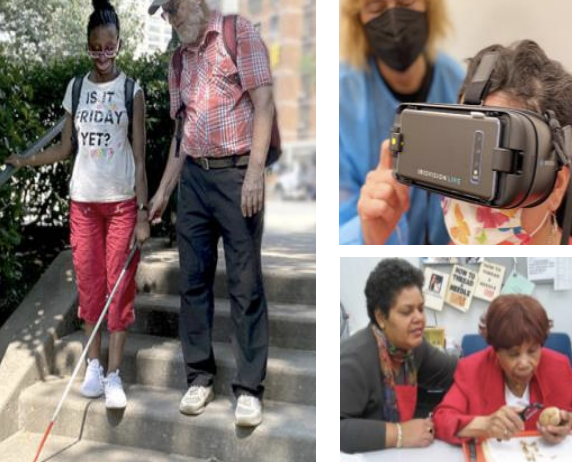
Behavioral Health Clinic
Offers in-person and tele-mental health services, with expertise in caring for people with vision loss, traumatic brain injury, diabetes and other chronic medical conditions
Services include:
Individual, couple and family psychotherapy
Psychiatric evaluation
Psychopharmacology and medication management
Group psychotherapy
Crisis intervention 24/7
Tele-support groups for adults with vision loss
Adult Day Health Care
Services available to adults ages 18 and older who have been diagnosed with a chronic medical condition
Offers an alternative to nursing homes
A team of licensed professionals provide:
Nursing care
Physical, occupational, and speech therapy
Medication management
Morning snack and noon meal
Social and therapeutic activities
Vision rehabilitation therapy
Tele-Support Network
Connects people of all ages from across the country to share resources, experiences, and support
Groups meet regularly via Zoom and are led by licensed professional
Tele-Support Groups for:
Parents of Children with Vision Loss
Teens, ages 14-18
Young Adults, ages 20 to 35
Adults, ages 35 and older
Additional Remote Offerings:
Virtual Book Club
Tele-Support Talks Monthly Series
Tech Talk Tuesday Monthly Series
Ask the TVI Monthly Series
eLearning for Professionals
Enables professionals to keep up with the latest technological advances and research findings for people with vision loss
programs for:
Ophthalmologists
Ophthalmology residents
Optometrists
Nurses
Social workers
Occupational therapists
Physician assistants
Teachers
Communicators
Technology Centers
Our new state-of-the-art-facility offers:
Assessments by Lighthouse Guild experts to determine visual capacity, lifestyle, personal goals, and comfort with technology
Opportunities to learn how to use cutting-edge and basic technology devices
e.g., using AI meta-glasses, CCTV, etc.
Training by experienced occupational therapists
Technology Workshops with our tech experts
e.g., pairing things to bluetooth
Tech Pals
When to Seek Services or Make a Referral
Significant complaints about difficulties with activities of daily living
Complaints about contrast or night vision
Feelings of anxiety, depression or hopelessness
Legal blindness, 20/200 or less in the better-seeing eye
Individuals who have not had a physical or eye examination within the past year
Definition of Low Vision
3 million Americans ages 40 and older have low vision - a permanent visual impairment that can't be fully corrected with glasses, contact lenses, medication, or surgery
Definition of Legal Blindness
In the United States, legal blindness is defined as visual acuity of 20/200 or less in the better eye with corrective lenses, or a visual field of 20 degrees or less
This means that a person with legal blindness can only see at 20 feet what a person with normal vision can see at 200 feet
It also includes those with limited peripheral vision, where the field of vision is restricted to 20 degrees or less
Eye diseases and conditions
Age-related macular degeneration (AMD)
one of the most common with aging
Glaucoma
second-most diagnosed
Diabetic retinopathy
a symptom of diabetes- an inability to see clearly
Maculopathy
Retinal detachment
Retinitis pigmentosa
genetic disease (not necessarily associated with aging)
Stargardt’s disease
Albinism
Optic nerve dystrophy
Visual field defect

macular degeneration
central visual field problem where you can’t see what’s in front of you
problems are immediately obvious
Leading cause of vision loss among Americans age 65+
Scotoma (blind spots) can vary in size, shape, and number
Rate of progression varies, but generally does not lead to total blindness
hard to predict; some people stable, some people not
Has a devastating impact on many daily activities
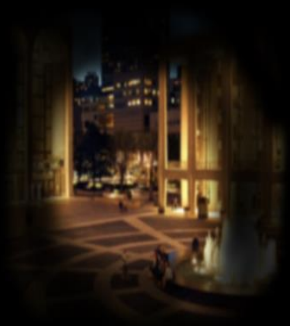
glaucoma
affects the peripheral visual field and gets worse with time
problems are noticed gradually (many people don’t even realize they have it)
No early symptoms; often diagnosed when damage is severe, irreversible, and too late to address
Most often caused by fluid build-up and resulting pressure in the eye
Causes
loss of peripheral visual field,
increased glare sensitivity, and
loss of contrast sensitivity
Impacts
driving,
mobility, and
increases the risk for falls

(diabetic) retinopathy
complex impairment where you have multiple blind spots (scotomas)
Complication of diabetes- caused by chronically high blood sugar levels
Damages the lens, retina, and macula
Causes multiple vision impairments
Impact's ability to…
recognize faces,
read,
manage medications, and
conduct self-examinations
Vision loss impacts a patient’s:
Independent living
Read mail, medication, food labels, and newsprint
Write a check
Dial a telephone
Shop for groceries
Prepare meals and cook
Participate in hobbies/activities
Travel and mobility
Cross streets
Read street and bus signs
Drive a car
Recognize faces
Socialize
Work and school
Use a computer
Use a tablet and/or phone
Read and write
Travel to and from work/school
Lost job, income, dignity
Dependent on strangers
Mental health
Depressed
Isolated
Embarrassed
Anxious
Abandoned
Referral to Occupational Therapy
At Lighthouse Guild, Occupational Therapists collaborate closely with:
Low Vision Optometrists
Primary Care Physicians
Social Workers
Low Vision Rehabilitation
Orientation and Mobility
Adaptive Technology Experts
They also coordinate programs such as
Tech Pals
Technology Workshops
Support Groups
Occupational Therapy Evaluation
Key Questions to Address:
What are patients’ visual impairments?
How do these impairments impact their daily activities and life roles?
What are the patient’s personal goals and priorities?
Occupational Therapy: Evaluation
Deficits and Restrictions in Daily Activities:
Work and productivity
how fast can you complete tasks?
Educational participation
Self-care and personal hygiene
Mobility and travel
Leisure and social engagement
Caring responsibilities
Vision Assessments Conducted by an OT
Basic Vision Assessment
Gather background information (history)
Determine the dominant eye
Assess visual acuity (intermediate distance)
Assess contrast sensitivity function
Assess color sensitivity
Assess visual field
Advanced Vision Assessment
Determine if a scotoma exists (if blind spot + if so, where it is)
Determine if depth perception is affected
Determine if binocular coordination is affected
Assess reading performance
Assess/address handwriting performance
Determine if glare is affecting performance

Visual Acuity Charts
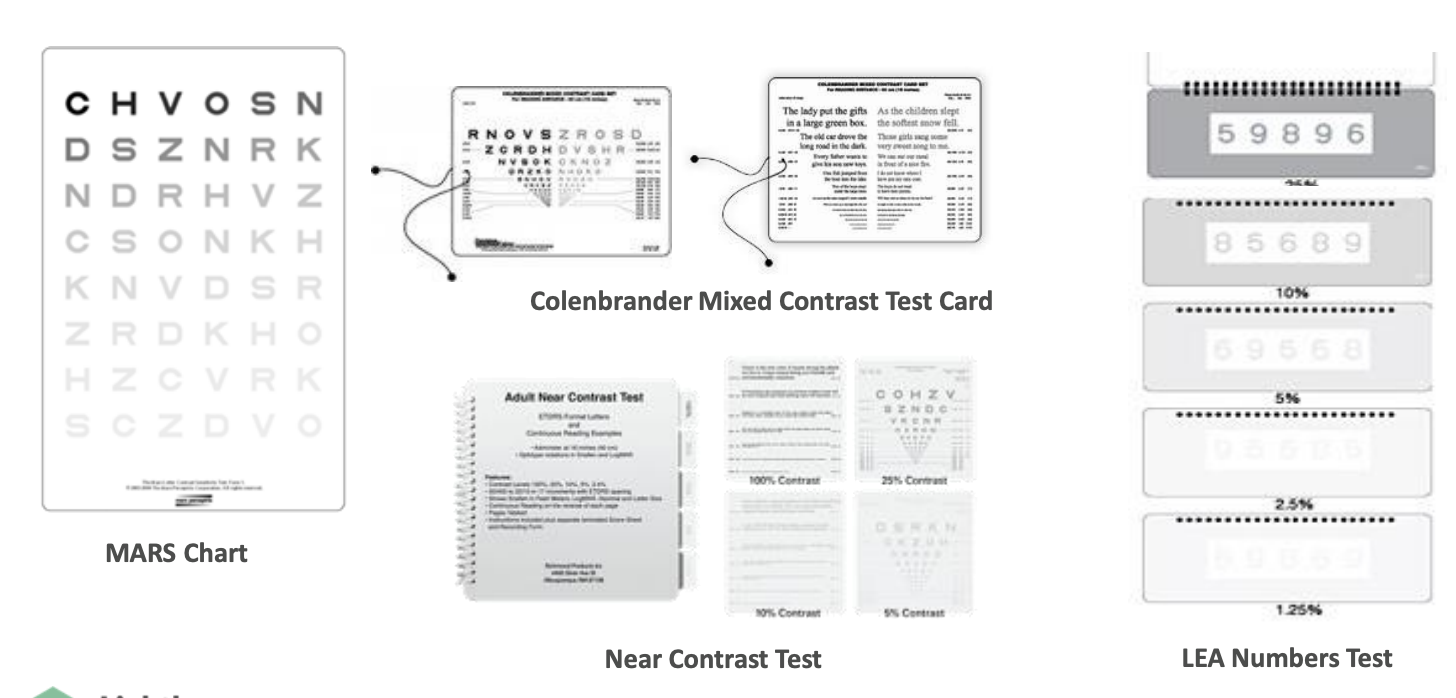
Contrast Sensitivity Charts
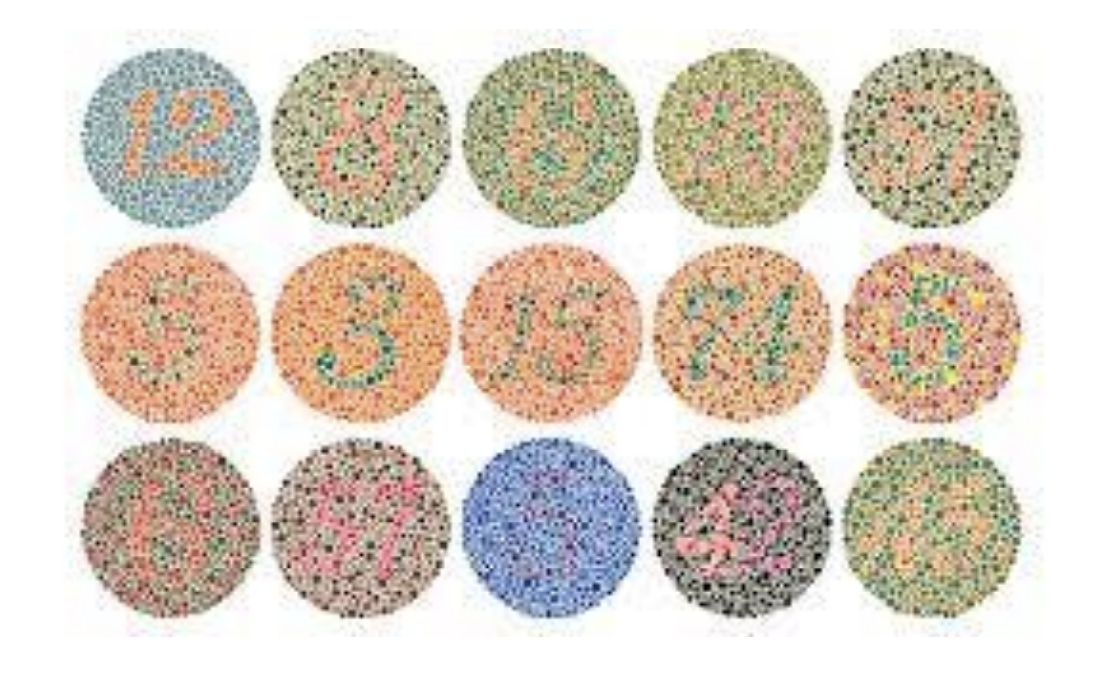
Color Sensitivity- Ishihara Color Vision Test
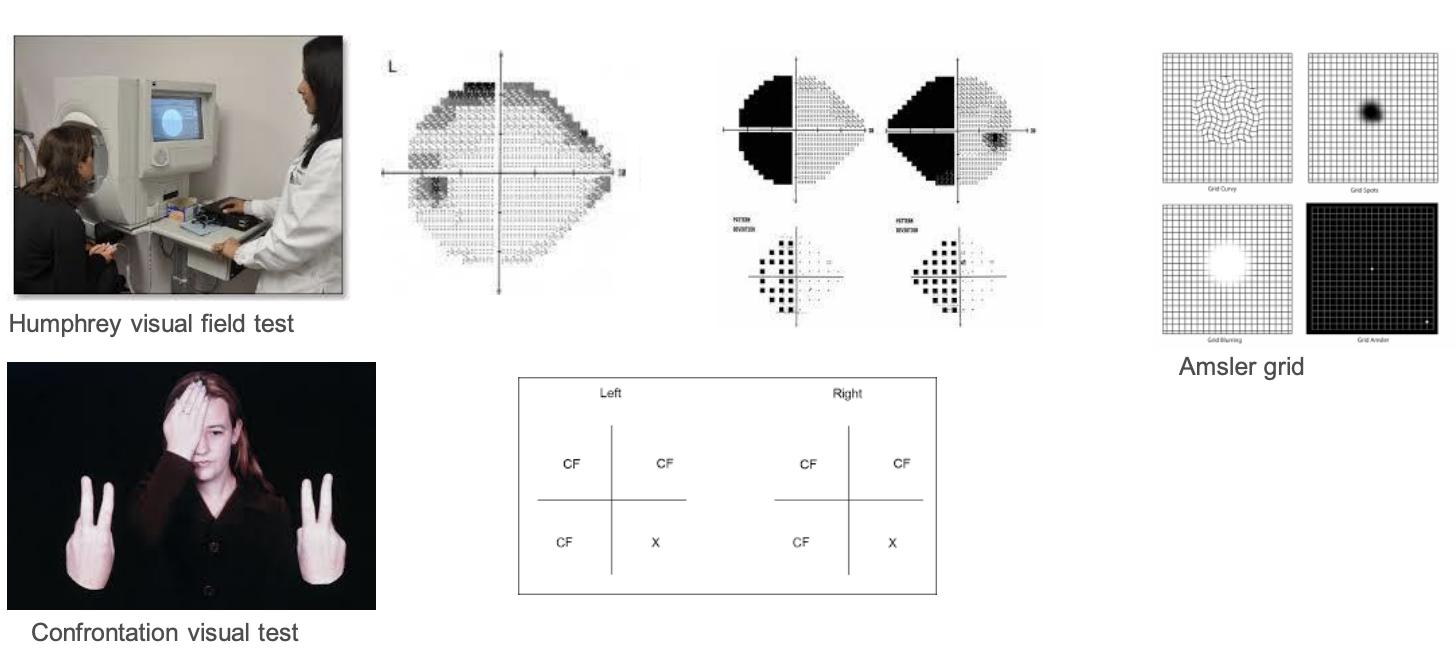
Visual Field Evaluation
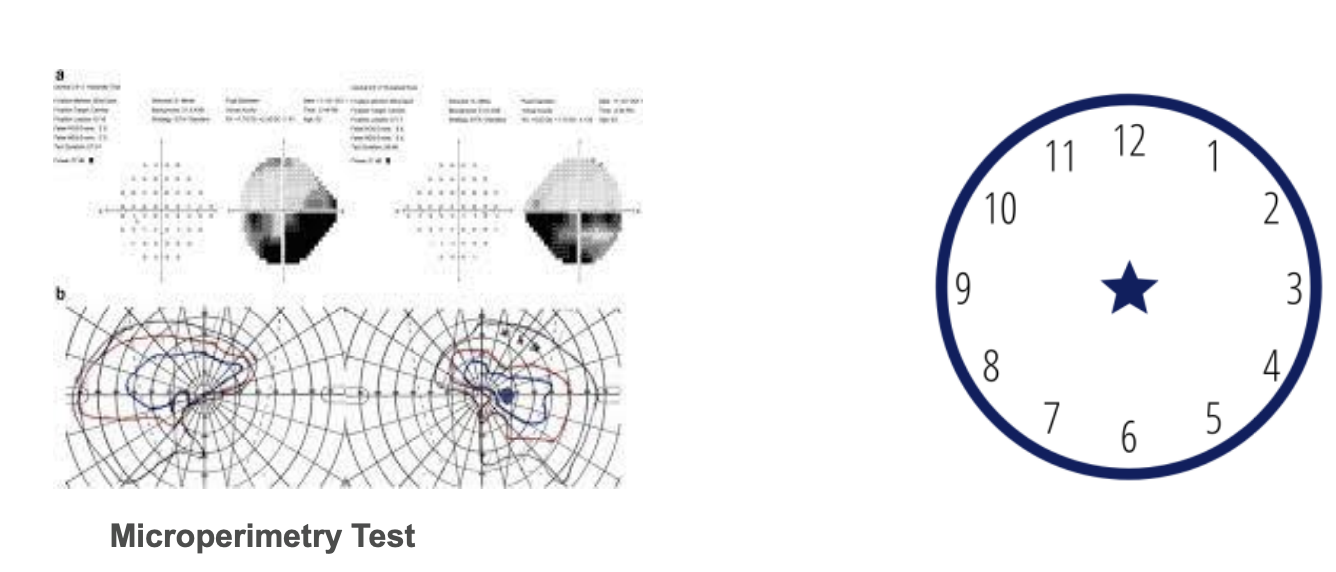
Central Scotoma/PRL Evaluation
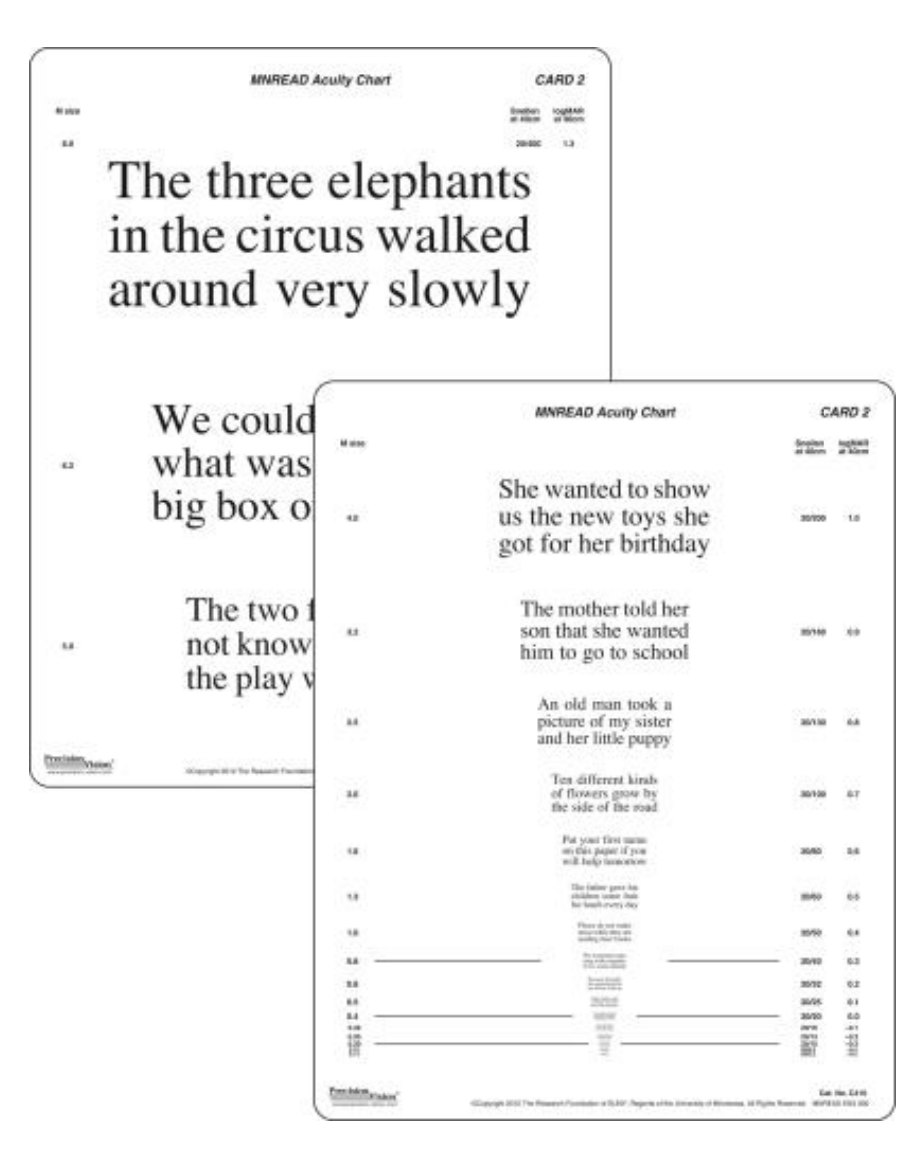
MN Read Acuity Test
Reading Acuity: Smallest print that can just be read
Maximum Reading Speed: Speed when reading is not limited by print size
Critical Print Size: Smallest print that still supports maximum reading speed
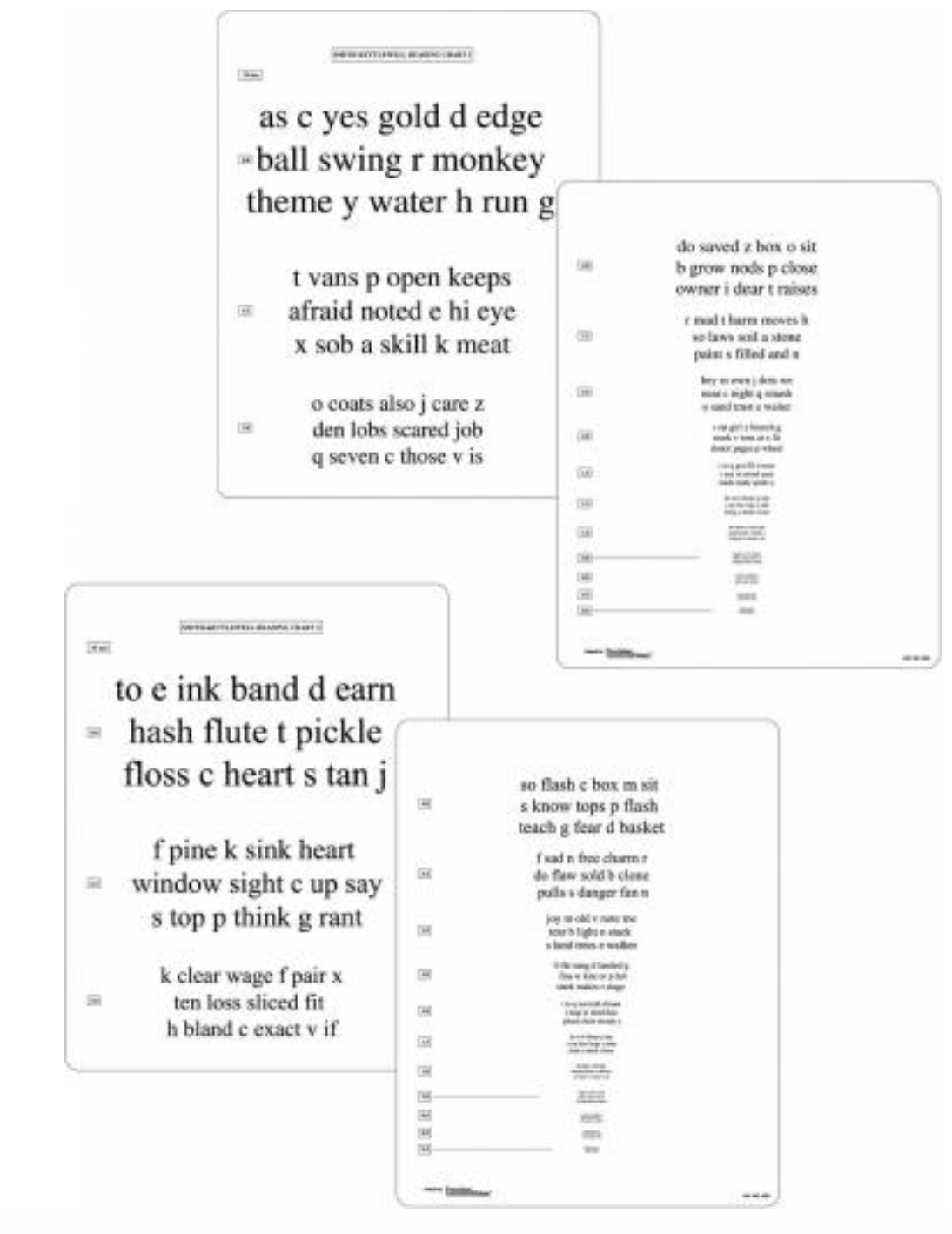
SK Read Test
Used to assess the reading performance of adults with:
Central or paracentral scotomas
Macular degeneration
Other conditions affecting the central visual field
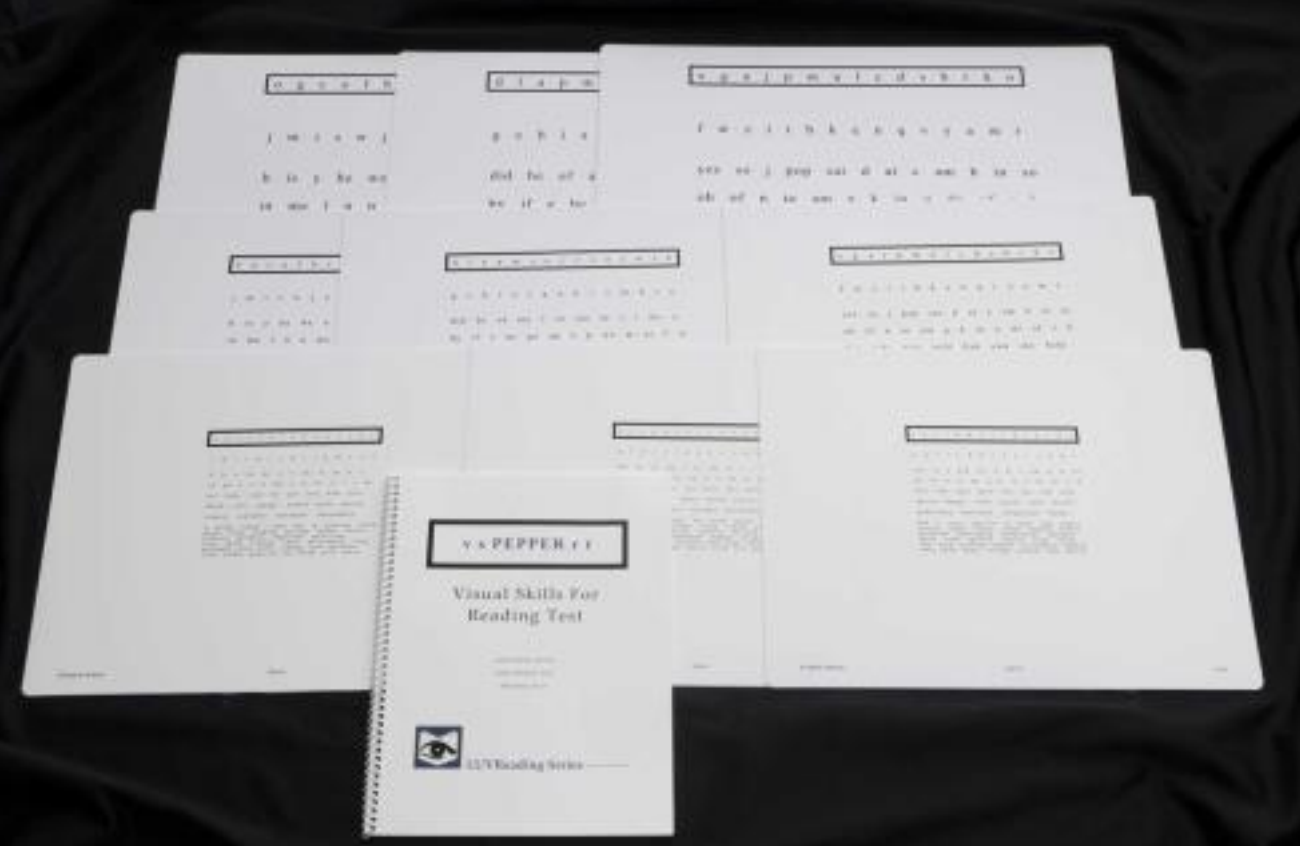
Pepper Visual Skills for Reading Rest (VSRT)
Designed to assess the reading performance of adult who previously read efficiently but now experience central scotomas due to macular disease, which interfere with fluent reading
ADL Performance Evaluation
The Canadian Occupational Performance Measure (COPM)
Client-centered assessment tool
Used to identify a client’s self-perceived occupational performance challenges
Measures changes in performance and satisfaction over time
Helps guide treatment planning based on client-identified priorities
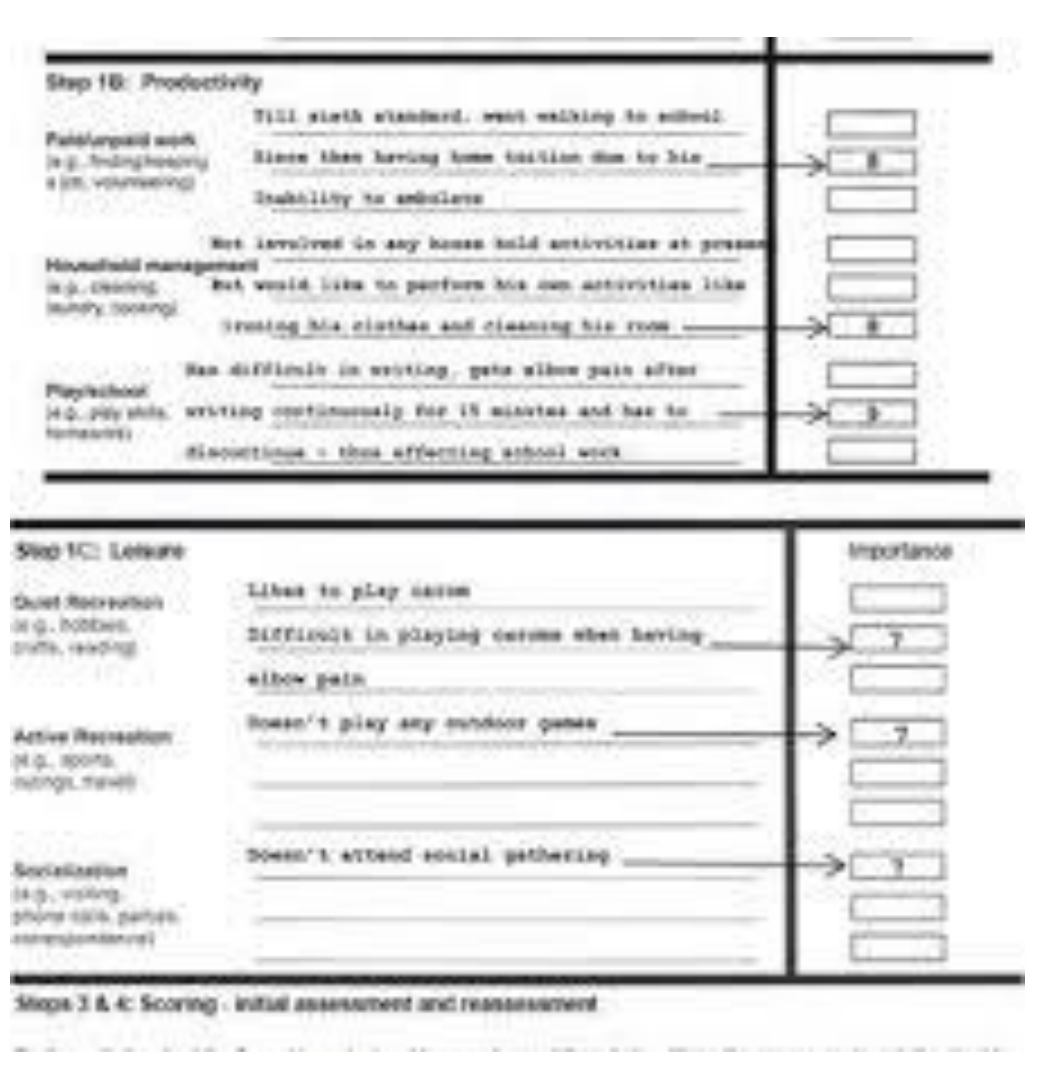
Four Levels of Interventions
Maximize visual function
(lenses, magnifiers, visual skills training, etc.)
Modify the task or environment to enhance visual performance
(large print, writing guides, better lighting, etc.)
Modify the task or environment to reduce or eliminate visual performance
(audio books and OCR software, etc.)
Eliminate the task
(alternate or substitute approaches)
Occupational Therapy: Environment Modifications
Education on Environmental Safety Modifications:
Identifying appropriate lighting
Enhancing the color contrast of surfaces and objects
Organizing and labeling items for easier access
Minimizing clutter to improve navigation
Implementing fall prevention strategies
Adapting home and work environments to support functional growth
Approaches to improve performance and safety include:
contrast around doorways
light switches in the bathroom
handrails and non-skid markings on stairs
window blinds to control glare
adequate and consistent lighting

Low Vision Adaptive devices: Meal Preparation
Basic adaptations for meal preparation:
tactile makings (“hi-marks”)
increased contrast
organization techniques
techniques for using sharps
liquid level indicators (“say when”)
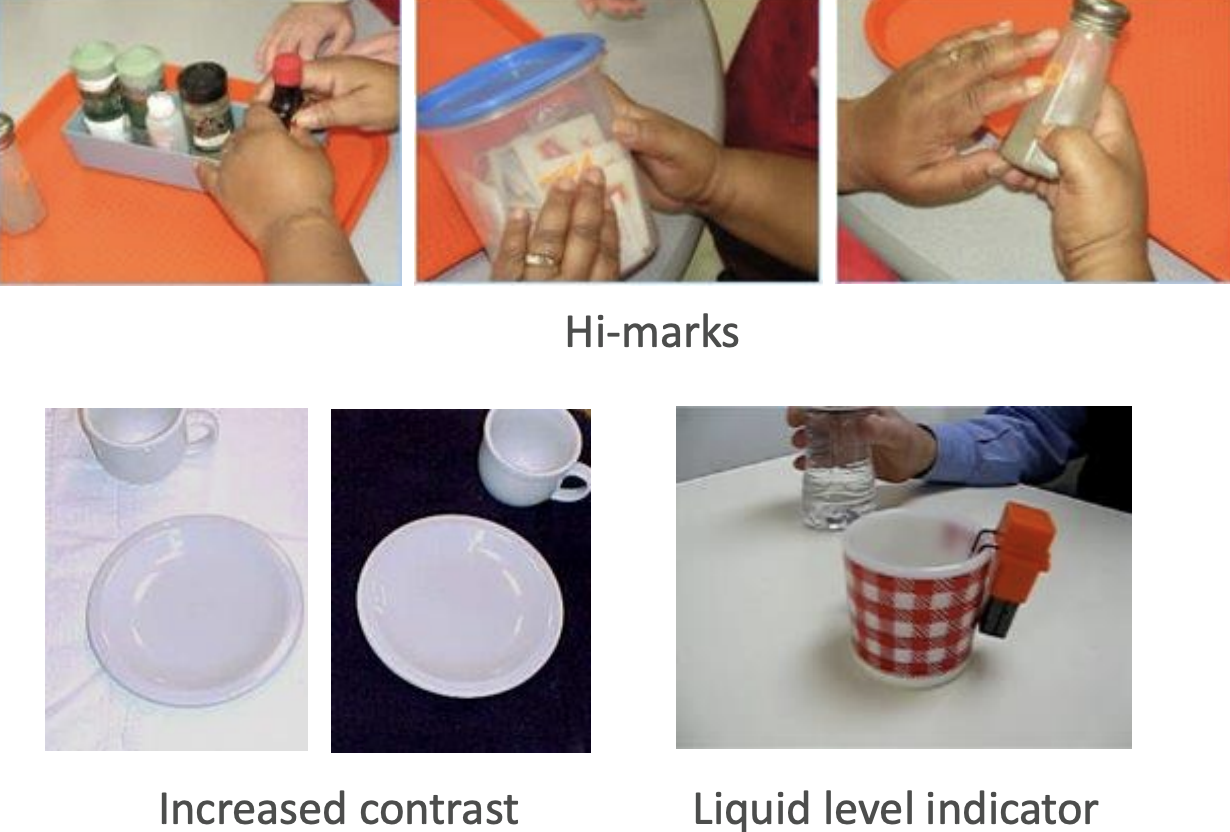
Low Vision Adaptive Devices: Health and Wellness
Simple approaches for health-related activities include:
large print and tactile pill organizers
auto-drop eye drop guide
talking glucometer for diabetic management
hand-held magnification for diabetic foot check

Low Vision Adaptive Devices:
Examples of Reading and Writing Interventions
a magnifier for reading small print
a hand-held telescope to spot items
signing name, and going off the line
using a typoscope as a signature guide

Occupational Therapy: Visual Skills Training
Visual Skills and Compensatory Strategies Training:
Eccentric viewing training
Scanning exercises for compensation of visual field constrictions
Exercises addressing loss of depth perception and eye-hand coordination
Binocular coordination and convergence tasks
Visual inattention retraining
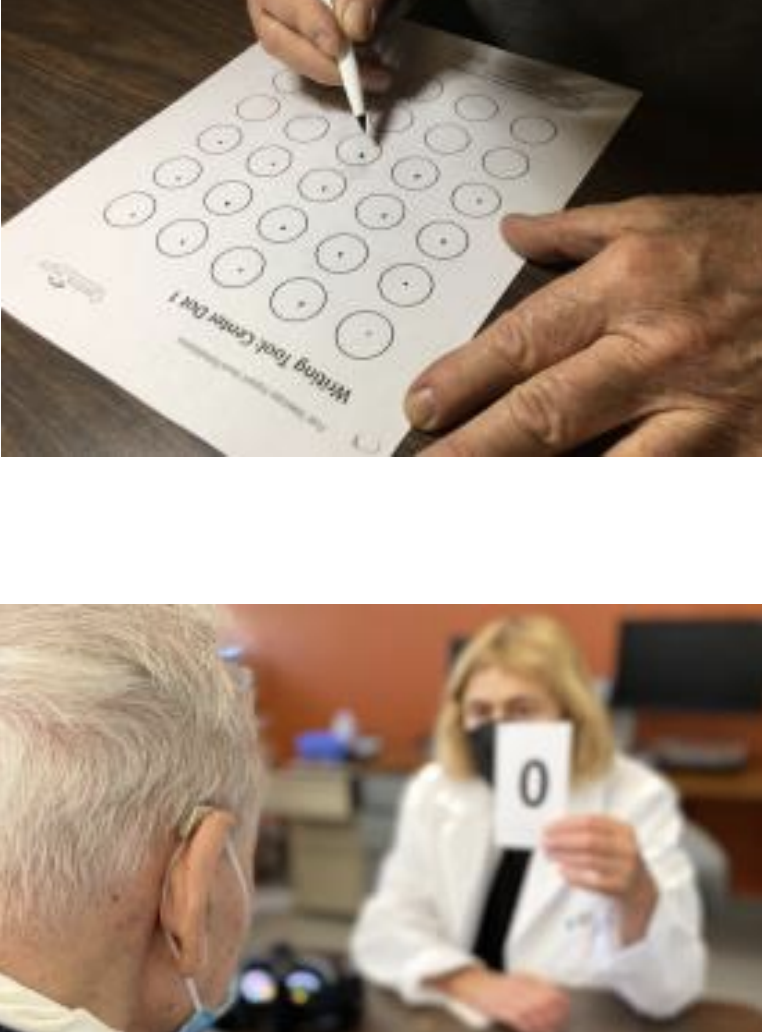
Adaptive Technology Evaluation
Adaptive computer equipment and software
Video magnification systems
Tablets and smartphones with accessibility feature
Apps designed for people with low vision
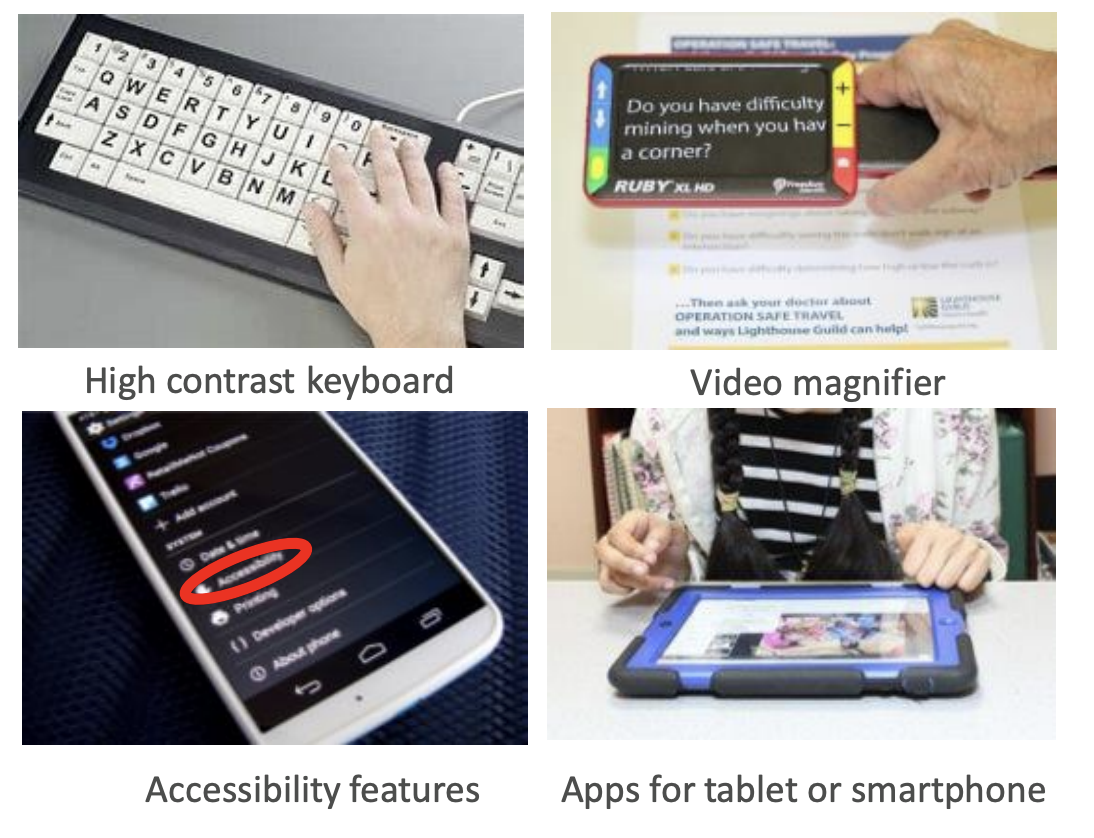
OT Evaluation and Therapy for Technology
OT specializing in low vision will meet with the patient to discuss personal goals and visual needs.
Patient’s history, assessment of their functional vision, and technical aptitude determine which technologies are best
Once the appropriate technology is identified, OT’s provide technology training to ensure patient is proficient and independent in its use
Occupational Therapy: Technology Evaluation
Identification and Training in Assistive Technology
Focused on individual capabilities, functional needs, and life goals:
CCTVs
Head-worn vision enhancement devices
Text-to-speech devices
AI devices
Hybrids
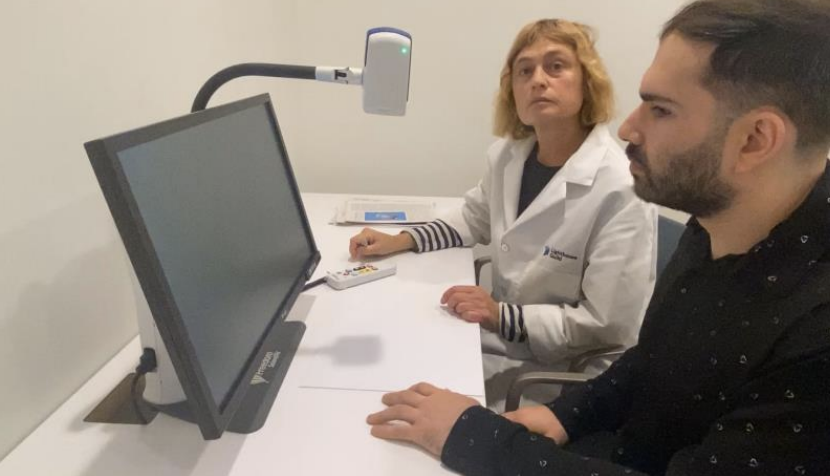
Onyx HD
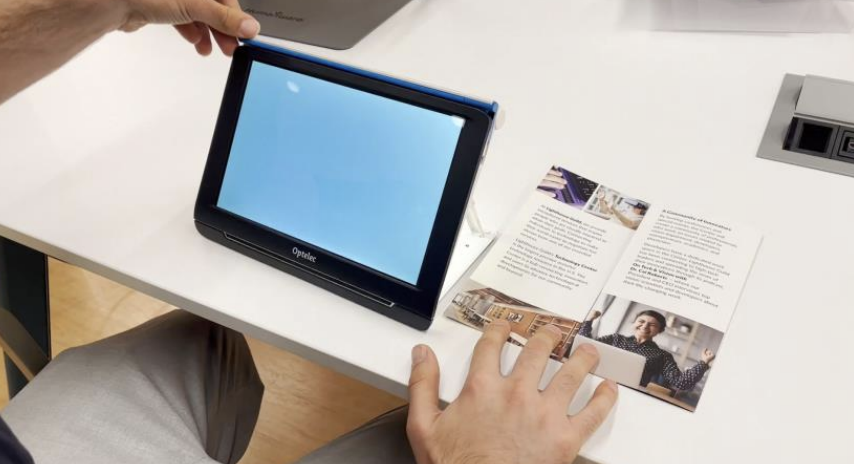
Optelec Electronic Magnifier with Text-to-Speech
listen + visually follow what’s on the screen
magnifies to make big letters
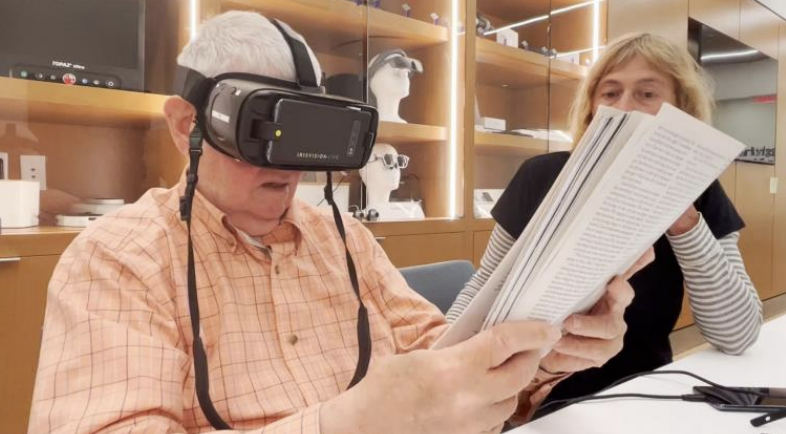
IrisVision
wearable magnifiers
good for watch TV, watching theater, watching sports game, other activities to do while sitting
NOT to be worn when being mobile/trying to drive
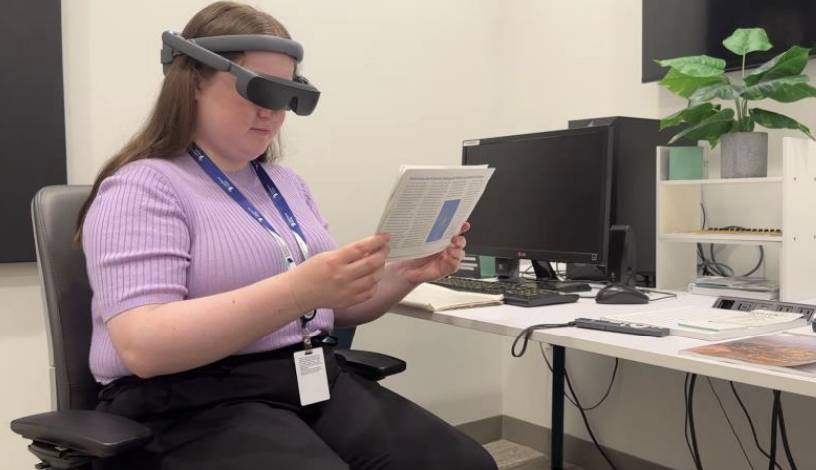
eSight
can switch gaze between looking into the device and looking onto the floor/your feet- so you know where you are; safer!
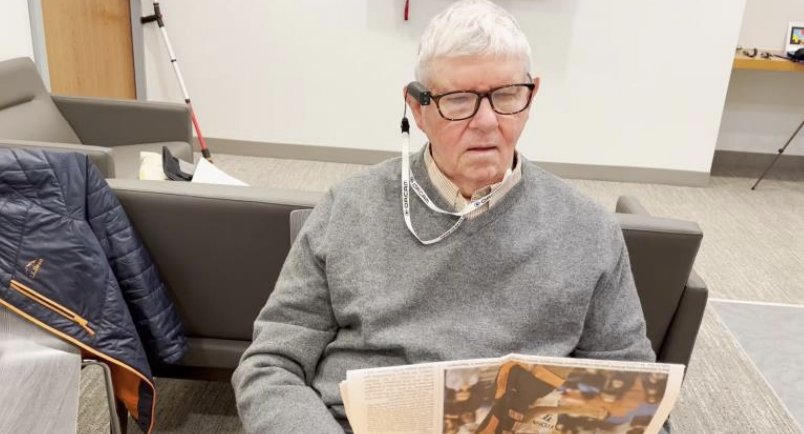
OrCam
turn text to speech
can describe the sceen
can tell you the color
has AI functions
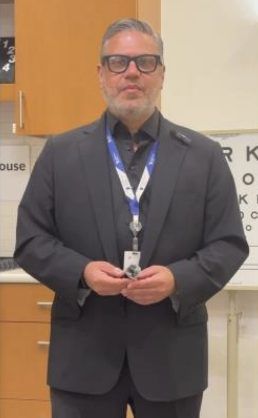
Ray-Ban Meta glasses
can take recordings- mostly used for leisure activites
AI will describe things you take photos/videos of
can also do live interpretations/translations of other languages now
Occupational Therapy: Technology Evaluation LVI logo
Training on accessibility features and assistive apps for smartphones and tablets
apps for navigation, magnification, etc.
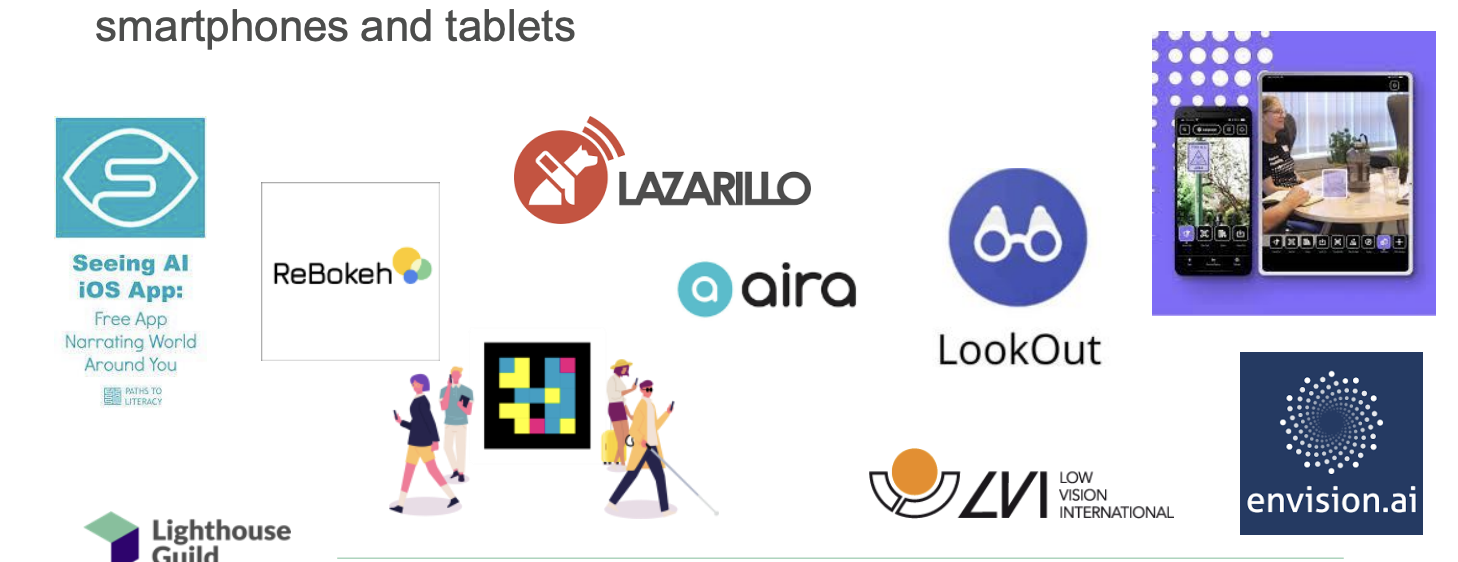
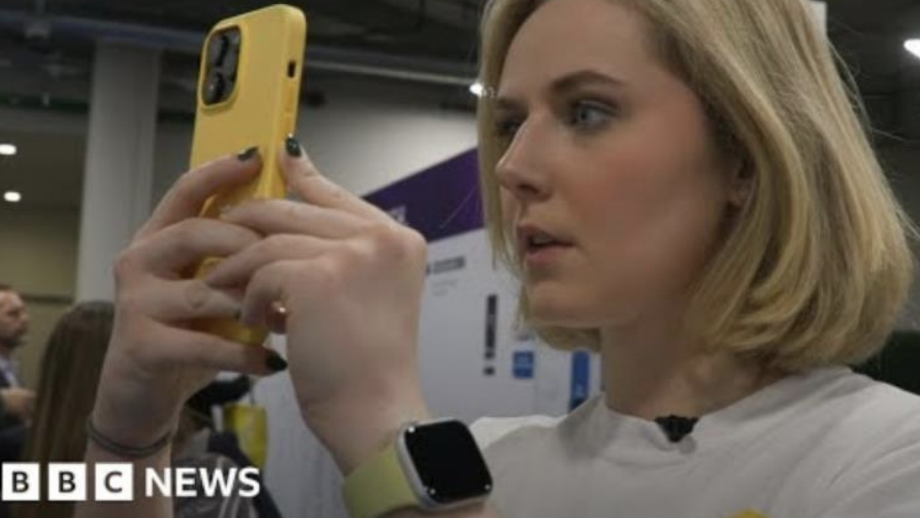
ReBokeh App
magnifying app that can also increase contrast, get more light, and generally make things easier to see with a variety of functions

Seeing AI App
free
similar to meta-glasses
reads text, describes scenes, describes colors, scans barcodes, downloads documents, and has them be read back to you, voice-over features, etc.
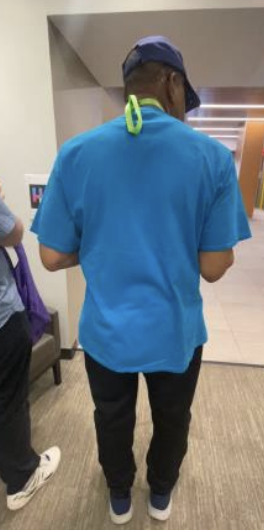
Navi-lens Mobility App Testing
Occupational Therapy Interventions for Low Vision
Environment modifications
Low vision adaptive devices
Visual skills and compensatory strategies training
Assistive technology and accessibility training